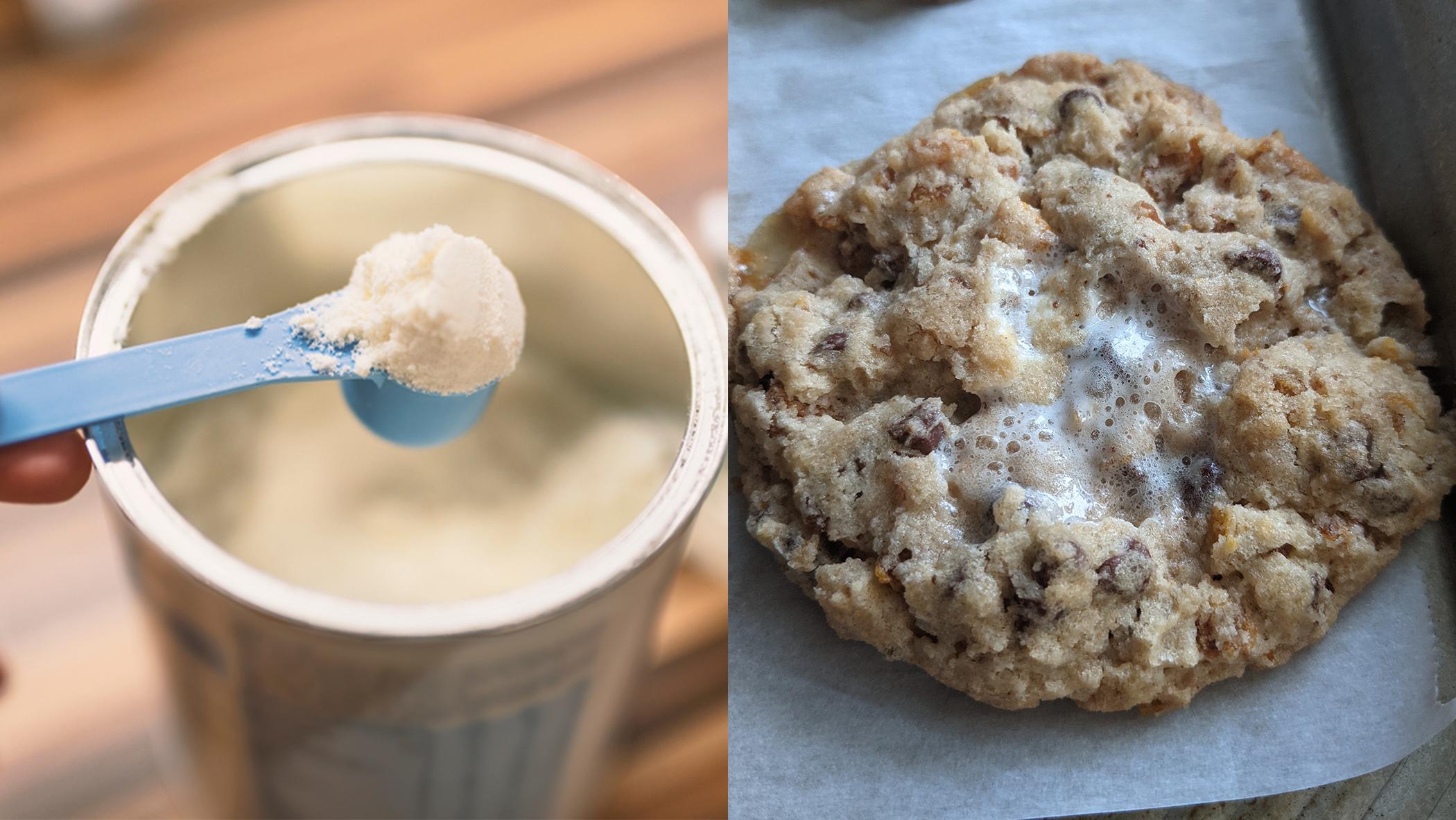Add This All-Purpose Baking Ingredient To Your Pantry (Or Bunker)
This unsexy, utterly practical staple makes desserts far more exciting.
I was in Washington D.C. last year for three days and managed to visit Milk Bar twice while there. Founded in 2008 by chef Christina Tosi, Milk Bar (co-owned by the Momofuku restaurant group) is a whimsical dessert chain specializing in nostalgia-based sundaes and baked goods whose colorful, playful vibe has informed the Instagram aesthetic for the past decade. Obsessed with Tosi's Cornflake Chocolate Chip Marshmallow Cookies, I set out to make my own batch once I got home, and the recipe called for an ingredient I didn't have much familiarity with: dry milk powder.
The cookies don't just call for cornflakes to be mixed into the dough straight from the cereal box; instead, a separate Cornflake Crunch recipe combines the cereal with a mixture of melted butter, sugar, salt, and dry milk powder, all of which gets toasted brown in the oven. The result is a rich, roasty flavor whose caramelized sweetness permeates the whole batch of cookie dough. And a lot of the flavor can be attributed to the 1/2 cup of powdered milk. As soon as I had it in the house, I wondered how I'd ever baked without it.
What is dry milk powder?
Simply put, dry milk is milk... without its liquid. Sorry, you probably assumed as much. The liquid has been completely evaporated out of the milk, leaving behind its solids, i.e. concentrated bits of protein that lend milk its flavor. Note that this is not the same as evaporated milk, which is what we call the canned milk product that has had 60% of its water removed. Evaporated milk is still liquid; milk powder has been further reduced to create a dry product for storing on the shelf and/or adding to baked goods, as the case may be.
"Milk powder has an amazing way of adding a terrific baseline flavor," Tosi told Epicurious in 2020. "It can make ice creams milkier, denser, silkier—and cookies chewier... It just makes things taste better."
How does it do this? By bringing all the benefits of dairy to a recipe without making it any more diluted, thin, or watery. It's so versatile that Tosi encourages home bakers to just toss a tablespoon of the stuff into whatever you're making and see if you end up with delicious results. You couldn't do that with regular milk; you'd risk ruining the batter with too much liquid.
How to use dry milk powder
Though my cornflake cookies only called for a 1/2 cup of powdered milk, I had to buy a 32-oz. canister of the stuff—but I'm so, so glad to have it on hand.
Right off the bat, let me say that it has saved my ass a number of times when I've forgotten to buy a gallon of milk at the store. You can just reconstitute some dry milk powder in water overnight: I put 3/4 cup water and just shy of 1/4 cup powder into a mason jar, screw the lid on, shake it like hell, and leave it in the fridge to set up overnight. (Food52 recommends adding a small amount of the water to the powder first, forming a paste, then incorporating the rest of the water gradually.) In the morning, I have enough milk for my coffee and my cereal, and it tastes indistinguishable from normal skim milk. If you're into building an emergency go-bag for your apocalypse bunker, powdered milk is a very worthy addition.
In baking, it really is as simple as Tosi says: try adding a few spoonfuls of milk powder to whatever type of dough you're making and see if you can taste the boosted richness of the final product.
When it comes to homemade hot cocoa mixes, milk powder is crucial; it contributes creaminess to the drink so that you don't have to use a base of straight-up heavy cream to achieve a rich texture. Alton Brown's recipe calls for a hefty amount of milk powder and also suggests toasting the powder in the oven first, in order to "capture a wide array of flavors, including caramel, toffee, and malt."
Ice cream is also helped by powdered milk, which can make your dairy taste more dairy-ish. In this homemade vanilla ice cream recipe, powdered milk helps the luxurious vanilla flavor stand on its own, without the help of mix-ins like chocolate chips or caramel swirl.
And here's our patented, life-alteringly delicious suggestion for how to use your powdered milk: toasted brown butter solids. What's that, you ask? It's an ultra-concentrated flavor bomb that takes five minutes to make and will vastly improve every sweet and savory dish in your repertoire. Add a pinch of toasted brown butter solids to roasted vegetables, whipped cream, pancake batter, cookie dough, cinnamon rolls, or pasta, and you'll never go back to the bland status quo.
